Julian Thomas, Engineering Director, TT Electronics discusses aircraft power advances at AFA’s 2024 Air, Space & Cyber Conference at the Gaylord Convention Center in National Harbor, Md.
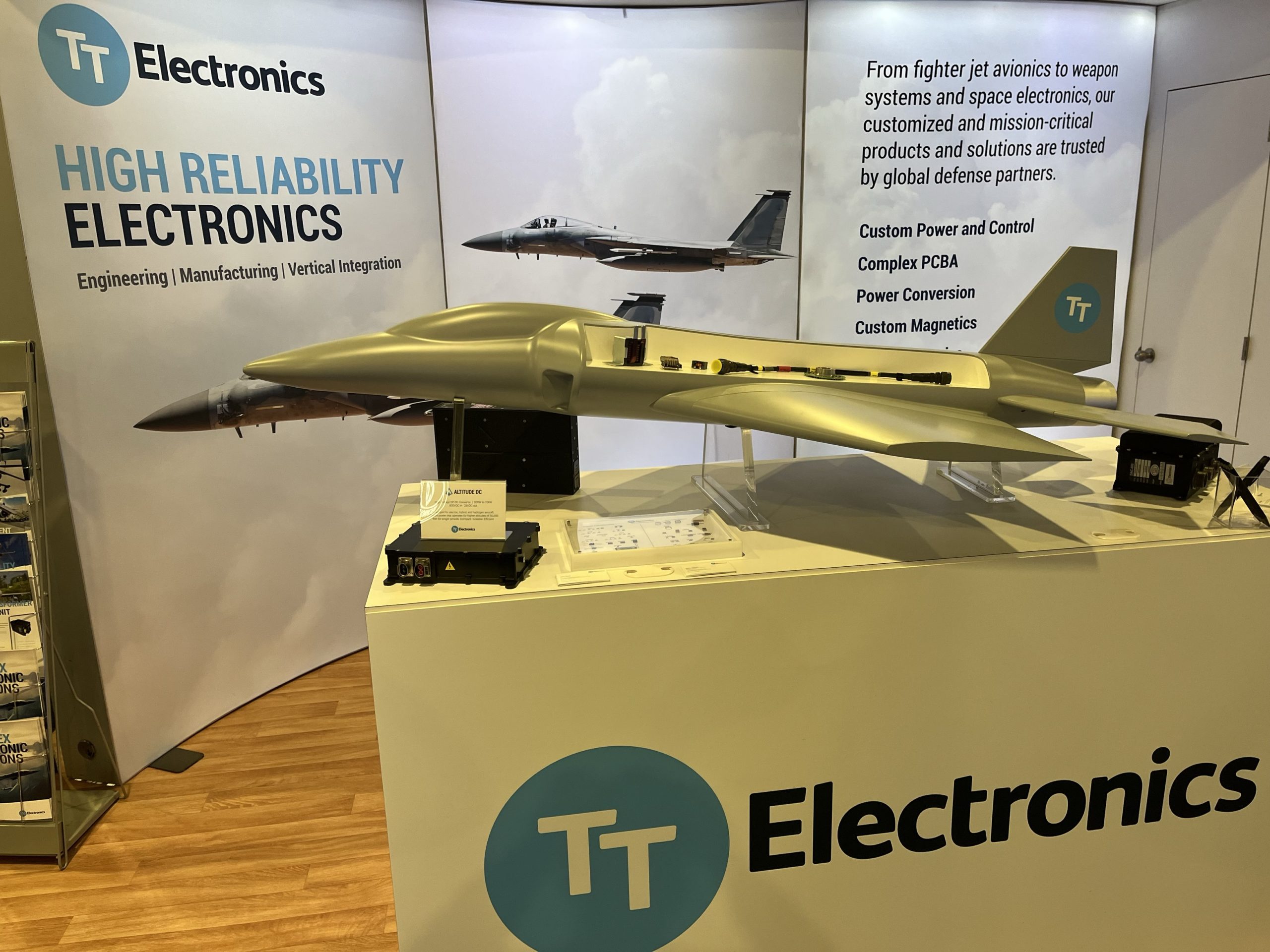

Julian Thomas, Engineering Director, TT Electronics discusses aircraft power advances at AFA’s 2024 Air, Space & Cyber Conference at the Gaylord Convention Center in National Harbor, Md.
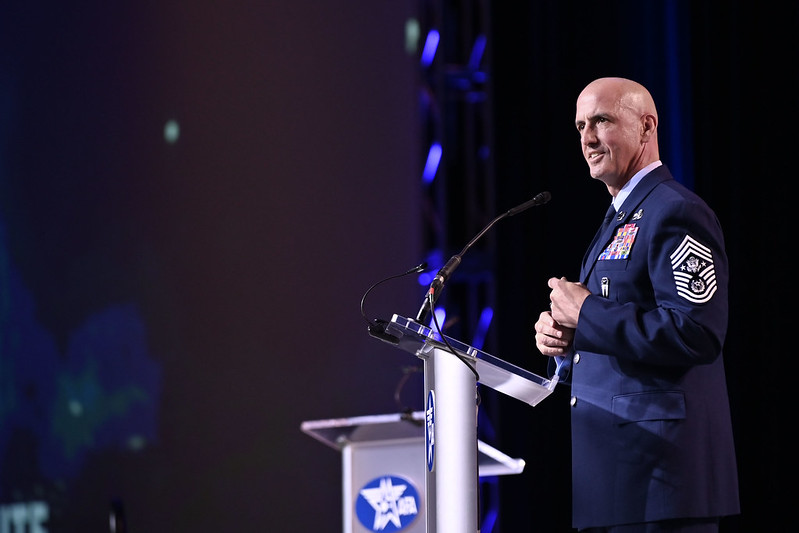
As the Air Force leans into the idea of mission-ready Airmen, Chief Master Sergeant of the Air Force David Flosi floated the idea of consolidating some of the branch’s more than 130 Air Force Specialty Codes while increasing training opportunities for Airmen to gain skills working in smaller teams.
Many Air Force enlisted job specialties involve similar work, Flosi told reporters at AFA’s Air, Space & Cyber Conference. He cited a recent analysis by Air Force headquarters, which identified 54 aircraft maintenance AFSCs, and noted that of the many tasks they train for, only 20 percent of them make up the vast majority of the work they do—80 percent, in fact.
Air Force headquarters sees “an opportunity to drastically reduce the total amount of AFSCs and build really good aircraft maintainers on that first 20 percent, which will provide us more agility on the flight line,” the chief said. “We’ll have more people that are qualified on the tasks that are most frequently done, and then bolt-on capability capacity.”
The Air Force has not made a decision to cut or combine similar AFSCs, but officials are analyzing career fields to see if reducing the number of specialties could make sense. Leaders say Airmen must be ready to handle multiple tasks when operating in an agile combat employment scenario, which involves working in smaller, disaggregated groups on a battlefield where enemy missiles are a constant threat.
“We’ll be contested in the air, on the ground, in the information environment. Supply chains are far more difficult in the INDOPACOM theater,” Flosi said. “So we need to put the smallest number of Airmen into harm’s way and achieve the maximum capacity out of each one of them.”
Each AFSC has its own pipeline and career path, which is great for technical specialization but not necessarily helpful in a contested environment, he explained. The Air Force plans to analyze the similarities between specialties within a career field such as aircraft maintenance, as well as the similarities between specialties in different career fields. Combining pipelines would eliminate stovepipes and increase flexibility, Flosi said.
“I’d be able to take this Airman that’s now qualified on more than one type of job, and I could employ her to do both, potentially, in an operational environment,” he explained. “So I’ve just now reduced our burden by 50 percent because we’re getting more capacity out of her.”
Many Airmen and units are already doing this. In his keynote address, Flosi pointed out Senior Airman Marlene Guerrero, a fuels technician with the 353rd Special Operations Wing who is also trained on hydraulics and is an assistant dedicated crew chief. Guerrero put those skills to work when she joined a repair team to fix a forward aircraft with a hydraulic problem. That’s not the kind of thing one would see at a large air base in the Middle East 10 or 15 years ago, Flosi said.
“You wouldn’t find somebody that was a crew chief and a fuels technician—ever,” he told reporters. “And so the fact that we’re not only training to that standard, but then employing that Airman with those multiple capabilities is game-changing, and that’s the type of thing we need to be able to do in a contested environment.”
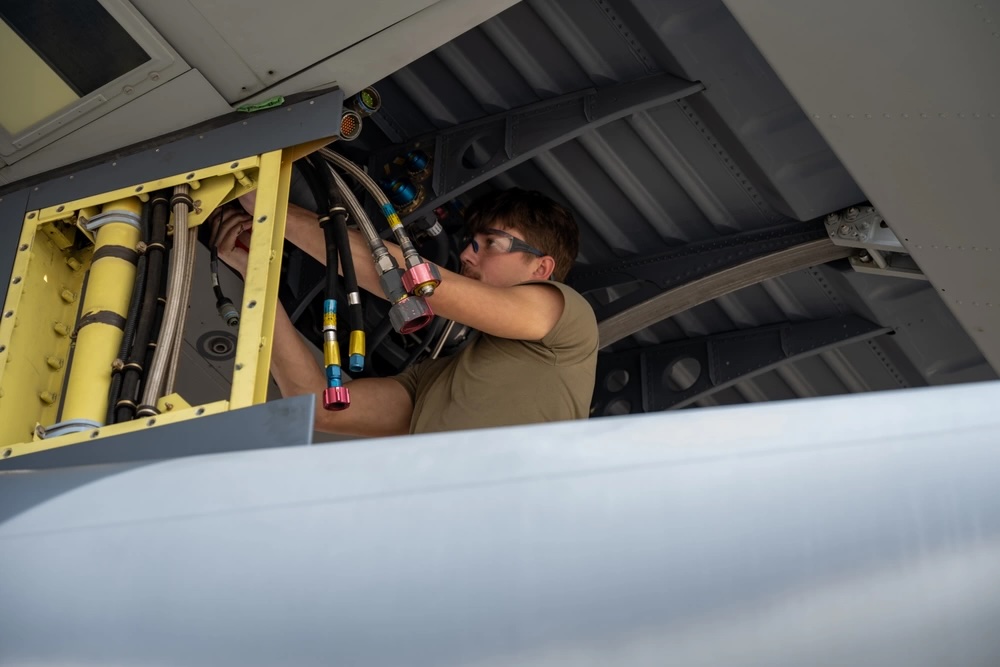
Another example Flosi offered was the 1st Special Operations Aircraft Maintenance Squadron, which developed a 12-member team capable of supporting multiple forward-deployed aircraft “for days on end,” Flosi said. The Airmen not only launched and recovered aircraft, but also supplied their own food, ammunition, water, security, and communications, a task that conventional planning would have required 40 or 50 people, he added. Cross-training Airmen made the smaller team possible.
“Even the air crew that lands can be qualified on a lot of those tasks to help with the mission while they’re on the ground,” Flosi said.
The Air Force is working on an “institutional backbone” to build out that kind of capability across the service, the chief said.
Flosi said Airmen should not see this effort to combine specialties and promote mission-ready skillsets as an attempt to do more with less. “We’re not trying to, like, squeeze 10 people’s worth of work into five people,” he said. “We want to have the capability for an Airman to do as much as they have capacity for.”
Judging that capacity is part of each commander’s risk calculations.
The Air Force will hold a two-day conference with wing commanders and command chiefs from across the service later this week. One of the major topics will be “taking risk in a smart and disciplined way,” Flosi said.
“We’re going to be talking more about that: how to ensure our commanders know we’ve got their back and we want them to execute and take risk when necessary, [but] to not overburden any particular Airmen,” he said.
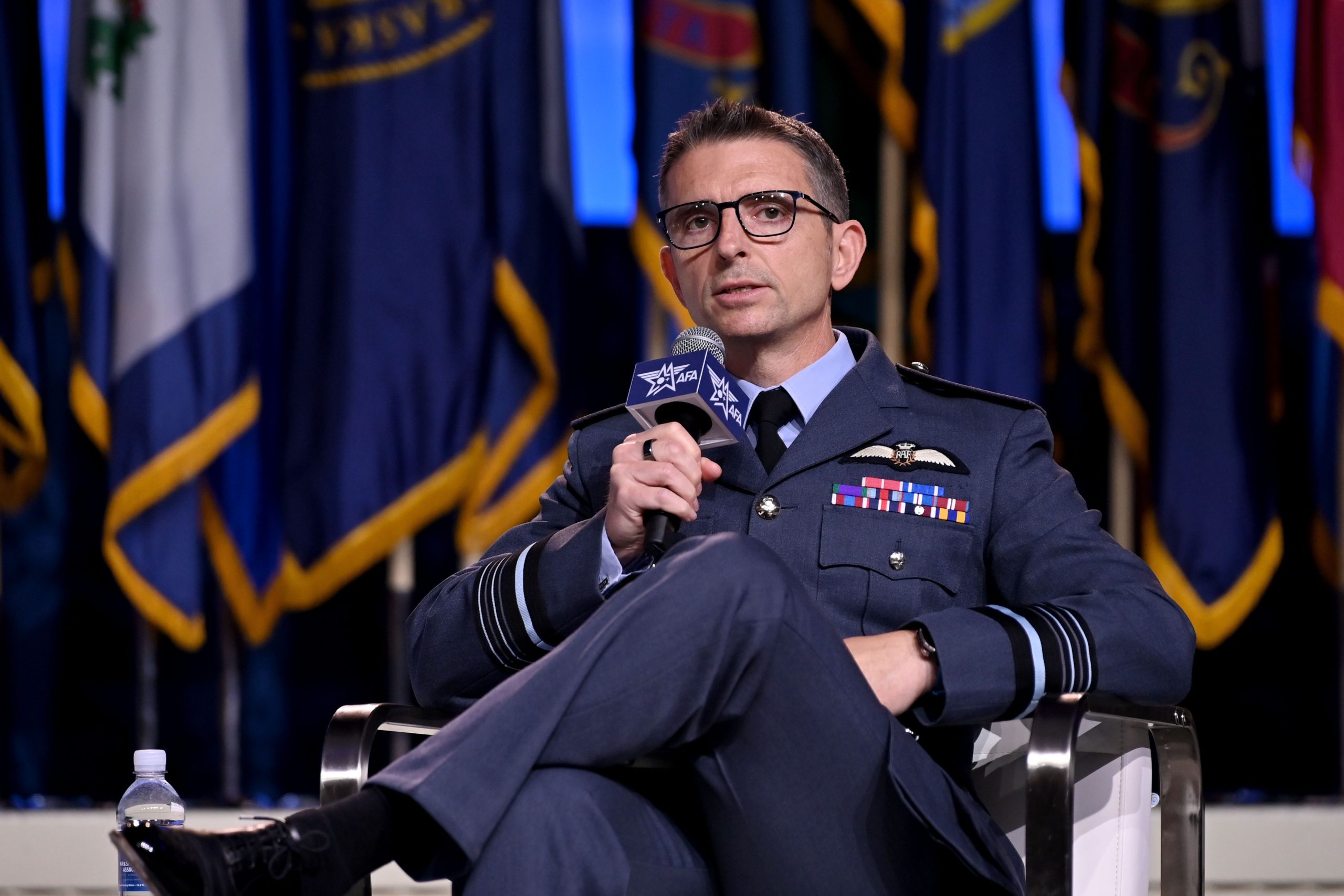
NATIONAL HARBOR, Md.—The Space Force has established a task force to envision its forthcoming Space Futures Command, but plans are still murky and the new command is still months from standing up.
A day after the Air Force announced a provisional Integrated Capabilities Command at AFA’s Air, Space & Cyber Conference, Space Force leaders said they are still in the midst of their analysis on how to structure its forward-looking Space Futures Command, which in many ways will be a counterpart to ICC.
Department leaders announced their intent to create a Space Futures Command in February, a fourth field-level command that would combine its Concepts and Technology Center, a Wargaming Center, and the the Space Warfighting Analysis Center, and tasked with tackling fundamental questions about the long-term needs and capabilities required of the U.S. Space Force.
But while that basic vision hasn’t changed, Chief of Space Operations Gen. B. Chance Saltzman said Sept. 17 that the definitions and structure underlying that vision are still in the formative stages in the hands of a small team he called “Task Force Futures.”
“We pulled people that were taking on some of the activities around the force—whether they were doing wargaming, whether they were doing force design, there’s some personnel from SWAC that do data analytics, and we tried to pull a smattering of a cross-functional team together, and they perform mission analysis,” Saltzman told reporters. “So it’s a very small team, less than a dozen people at this point. They’re just trying to ask the right questions, frame the discussion so they can see what resources are going to be necessary.”
Led by Lt. Gen. Shawn Bratton, the Space Force’s chief planning officer, the task force recently held a tabletop exercise to examine how best to organize the command.
“The tabletop exercise was just almost an opportunity to see OK, how does the flow of data go through Futures Command?” he said. “How do you go from key questions into how it might be documented as a contributing element to our objective force. Who has to do what? How do we use wargames? How do we use experimentation? Are there demos? Do we need acquisition authorities? Do we need capabilities developers? Is this all about strategy? How do we infuse intelligence, the intelligence apparatus of the service, into those efforts?”
From exercises like that, Saltzman added, the task force will craft requirements for Space Futures Command—authorities, manning, and processes it needs. But while other Space Force leaders previously said Space Futures Command could reach an initial operational capability before the end of 2024, Saltzman indicate a more deliberate pace.
“We’ve identified a team to get us to initial operating capability, and they’re going to make it happen, if not by the end of this year, I guarantee you within a year,” he said during his keynote address. Asked about it later during a press conference, he told reporters that “what we want to focus on is putting things in place based on key milestones for effectiveness … [rather than] a time trigger.”
The new Space Futures Command has the advantage of pulling exisiting elements and personnel together, rather than building everything from scratch, as Bratton has noted in the past. The SWAC exists, as does Space Delta 10, which handles doctrine and wargaming. Yet that is still no small feat, said RAF Air Marshal Paul Godfrey, the first assistant chief of space operations for future concepts and partnerships. Godfrey has firsthand experience—he was the first commander of the U.K. Space Command when it started in 2021.
“We’re kind of building the plane as we’re flying it already, because the SWAC is already out there,” Godfrey said. “The Wargaming Center is already out there. So actually from my own experience of standing up a command in the United Kingdom, which brought together a couple of extant areas … I think the priority will be trying to get the mechanism up and running.”
Godfrey suggested the new command may be “undermanned” to start, even if the total manpower required is relatively small.
“There aren’t that many new people required,” he said. The Concepts and Technology Center is new, but the Space Warfighting Analysis Center already exists and “when you talk about the Wargaming Center, that’s currently there with Delta 10,” Godfrey added. “So actually, the personnel budget is reasonable. There’s a headquarters element, as well, so all those elements will be about 600 or so personnel.”
Futures Command will have to work closely with other field commands and military space organizations to be effective, but those dependencies mean it should also be be a powerful connector—and money-saver—for the Space Force.
“It does become the front door, I think, for allies and partners to go and understand where they can contribute, where they can add value to the United States, where we can ultimately build what’s termed an objective force … that actually has allied capabilities integrated into it,” said Godfrey, whose assignment on Saltzman’s staff itself symbolizes the kind of close international partnerships the Space Force envisions with allies.
“When we do our force design … it’s one thing to say we’re going to need this much SATCOM in our objective force,” Saltzman said. “But if you say, ‘Well, hold on, what can the UK bring? What can the French bring? What can the Germans bring, or the Australians and Canadians bring?’ And if we understand—knowing that if we’re going to be in a large-scale conflict with our coalition of partners that then we’ll have access to these capabilities—we can produce a more insightful force design that maybe doesn’t [need to] buy resources that we can get from other nations.”

NATIONAL HARBOR, Md.—Troops and their families can now purchase Narcan from their local exchange as the military grapples with the effects of the national opioid epidemic.
Making Narcan, the naloxone nasal spray that can reverse an opioid overdose within minutes, more widely available to the military community through Army and Air Force Exchange Service stores may curb drug-related deaths among service members and their loved ones.
“If you look at where our bases are, there’s a very definite Venn diagram over areas that are being affected, unfortunately, by this epidemic,” Lt. Col. Sharon Arana said at AFA’s Air, Space and Cyber Conference here Sept. 17. “The intent was to remove a barrier to access for this critical medication for our families.”
Arana leads Air Combat Command’s Sword Athena team, one of a network of Airman-led groups that spearhead changes to policies that affect the readiness of Airmen and their families.
The change was spurred by a Sword Athena event at Joint Base Langley-Eustis, Va., in February that brought together command staff and military families to discuss issues that may have fallen under the Air Force’s radar. The event raised problems with access to Narcan, prompting Sword Athena to reach out to AAFES to make the spray more easily accessible, Arana said.
Narcan is now available in AAFES stores and online. A two-pack of Narcan, which doesn’t require training to administer, currently costs $44.99 on the exchange website. The store also offers pouches to carry the antidote on the go.
Last year, the Defense Department reported more than 300 fatal overdoses among Active-Duty service members between 2017 and 2021, and nearly 15,000 non-fatal overdoses from 2017 to February 2023, when the Pentagon responded to an inquiry from Sen. Ed Markey (D-Mass.). About 175 of those fatal overdoses involved fentanyl, a potent synthetic opioid.
About 81,800 people died of opioid-involved overdoses in the United States in 2022, according to federal data.
The 2024 National Defense Authorization Act mandated that by Jan. 1, 2025, the Pentagon must issue regulations to ensure the antidote is available on all military installations and each operational environment, as well as to track the naloxone that is distributed.
The department must also track the illegal use of fentanyl and other controlled substances across the military. Congressional lawmakers called for a briefing on the progress of efforts to curb substance abuse no later than June 1, 2025.
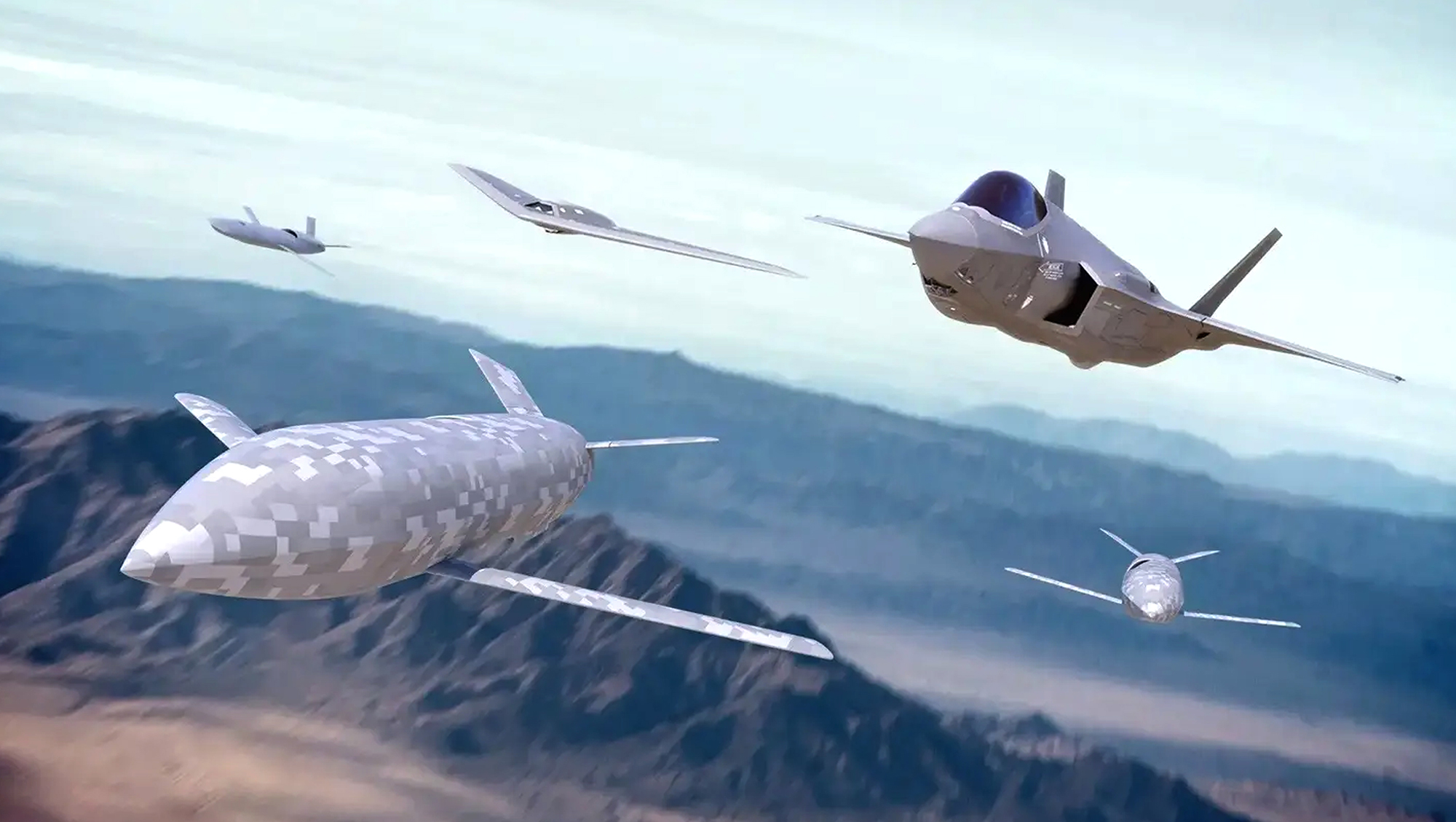
NATIONAL HARBOR, Md.—Lockheed Martin, having “gold-plated” its initial bid for the Collaborative Combat Aircraft program, will focus on lower cost, more attritable aircraft in its proposal for the second increment, the head of the company’s legendary Skunk Works division told reporters Sept. 17.
“What we see from a macro-level environment is … something that has more expendable characteristics and is at a much, much lower cost point seems to be a good place to go explore. And so that’s where we’re exploring and putting time and energy in,” said John Clark, a Lockheed vice president and general manager of the experimental engineering outfit. He spoke at a briefing at AFA’s Air, Space & Cyber Conference organized by the defense contractor.
He added that the Air Force was still developing requirements for Increment 2 of the CCA program, which aims to produce uncrewed, autonomously piloted aircraft that will partner with manned fighters like the F-35 and provide additional firepower.
“Right now we’re actively looking at how the Air Force is going to go with their requirements,” he said, adding that he did not want to get out ahead of service leaders.
But he also cited the famous advice from ice hockey legend Wayne Gretzky: “’Skate where the puck is going to.’ That’s where we think it’s going to,” he said.
Lockheed was one of three unsuccessful bidders for Increment 1 of the CCA, and Clark said the company offered stealth capabilities in that bid that were above and beyond what the Air Force requested. He attributed that decision to the company’s conviction, based on its operational analysis, that stealth was required to make the aircraft survivable and capable of providing “something that actually had value to the Air Force over long haul.”
“With 20/20 hindsight, you could certainly armchair quarterback [that decision] and say, well, the Air Force isn’t valuing survivability right now, so we gold-plated something that they didn’t need gold-plated,” he explained.
Because of the physical characteristics of the winning designs for the current generation of CCA aircraft, and in particular the tail fins, they are likely to be visible to the enemy long before they are able to deploy their sensors, Clark said.
“These tails on the side … are big reflectors,” he said, making the aircraft visible to enemy radar, “which is why, when you look at things like the B-21 [bomber] or … the RQ-170 [Sentinel UAV] they don’t have tails.”
“The whole objective with [intelligence, surveillance and reconnaissance, or] ISR, is you’re trying to create an asymmetric advantage. If I can see you well before you can see me, I have an information advantage, and I can exploit that information to my benefit,” he said.
Clark added there is a trade-off between visibility and affordability. “I think that there will be a reckoning to come at some point when acquirers are looking at, ‘All right, I’m going to spend $15 million or $20 million an airplane, and the [operational analysis] is telling me that 80 percent or more of them don’t make it home.’”
That begs the question of what is the sweet spot for balancing cost and survivability, he said. “How many airplanes am I willing to spend that sort of money on before that’s a losing proposition financially as a nation?”
He said he was “very interested in how the Air Force will ultimately choose to go down that path. What is the right place [in the force structure] for an expendable asset, and what’s the right place for an attritable asset, and where do you want to have something that comes home every time?”
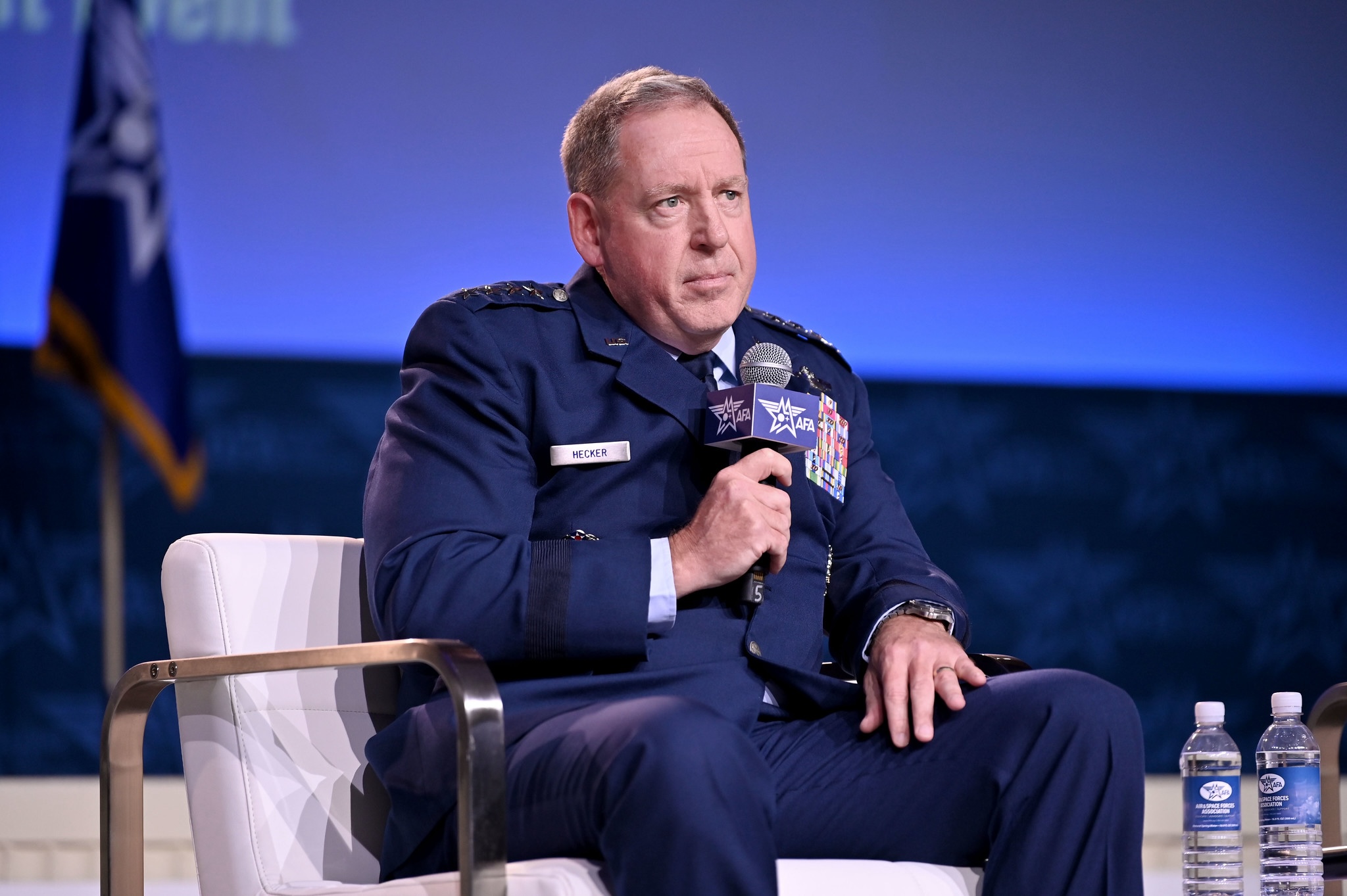
NATIONAL HARBOR, Md.—Ukraine is taking a cautious approach toward employing its new F-16s, the top U.S. Air Force officer in Europe said Sept. 17.
“The pilots are new to it, so they’re not going to put them at the riskiest missions,” Gen. James B. Hecker, the head of U.S. Air Forces in Europe and NATO Allied Air Command, told reporters Sept. 17 at AFA’s Air, Space & Cyber conference. “Ultimately, that’s a Ukrainian decision. But I think that’s the approach that they’re taking.”
Ukraine first began flying the F-16 in August, and the aircraft has already proved successful in shooting down Russian cruise missiles and drones. But in one missile and drone barrage, a Ukrainian F-16 crashed, killing its pilot. Ukraine is investigating the incident.
Ukraine’s Air Force commander was fired soon after. Hecker said the U.S. has offered its assistance, but the U.S. had yet to “see if they take us up on that offer.”
The U.S. has not only trained Ukrainian pilots and maintainers but is also trying to boost the status of the country’s air force within the Ukrainian military.
“In a lot of the former Soviet Union countries, the army was kind of the service, and everybody else was below that and maybe didn’t get a voice at the table,” Hecker said. “So I have been asking that the Air Force get positions on the General Staff.”
The goal, which Hecker said is backed by U.S. Army Gen. Christopher G. Cavoli, the head of U.S. European Command and the NATO Supreme Allied Commander, is to enable Ukraine’s air force to do more joint operations with the country’s ground forces.
Despite doubts that Ukraine would be able to maintain the jets, Hecker said Ukrainian maintainers are succeeding. “We’ve trained a lot of Ukrainian maintainers, and from all accounts, when I talk to the instructors that are training them, they catch on very quickly,” Hecker said. “I know they’re flying. That’s good news.”
The Biden administration has shelved a proposal to hire American civilian contractors to help maintain the aircraft, hoping instead that contractors from European nations will assume some of that responsibility.
Meanwhile, Ukrainian F-16s are likely to be employed mainly in an air defense role as its air force develops the skills and understanding to leverage all its capabilities.
To date in the war, Ukraine has shot down more than 100 Russian aircraft, Hecker said, and Russia has shot down at least 75 Ukrainian aircraft. That’s kept both sides from fully employing its fighters for fear of losing them.
“What we see is the aircraft are kind of staying on their own side of the line, if you will,” Hecker said.
“What none of us probably forecasted is that nobody would get air superiority, neither Ukraine or Russia,” he said. “And now it’s been two and a half years, and neither one has, and that’s because of the integrated air and missile defense systems that both of them have.”
Russia is continuing to field glide bombs, ballistic and cruise missiles, and drones, increasing the air defense mission for Ukraine. In addition, Russian President Vladimir Putin recently ordered an increase in Russia’s military to some 1.5 million troops. “Russia is getting larger, and they’re getting better than they were before,” Hecker said.
Ukraine has been promised at least 80 F-16s, with the first aircraft coming from Denmark, the Netherlands, Belgium, and Norway. On Sept. 17. Ukrainian President Volomyr Zelenskky said the country had a new “ambitious” strategy to “increase the number of combat aircraft in Ukraine and speed up our pilot training.”
U.S. and Denmark are leading the training, but the U.K. and others are also training pilots on Western tactics in jet aircraft. There are over a dozen countries in the Ukraine Defense Contact Group’s Air Force Capability Coalition, co-led by Denmark, the Netherlands, and the United States. That group is “advising Ukraine and providing training, funding, aircraft, and critical equipment” to build up a fouth-generation fighter force, according to U.S. Navy Lt. Cmdr. Javan Rasnake, a Pentagon spokesperson. After a Sept. 6 meeting of the Ukraine Defense Contact Group, Canada said it would train new pilots without previous flight experience. The Ukrainian pilots training in the U.S. and Denmark have previous experience flying Soviet-era combat aircraft.
“We can’t train them fast enough,” Hecker said. “The good news is we have a coalition that is helping with the training.”
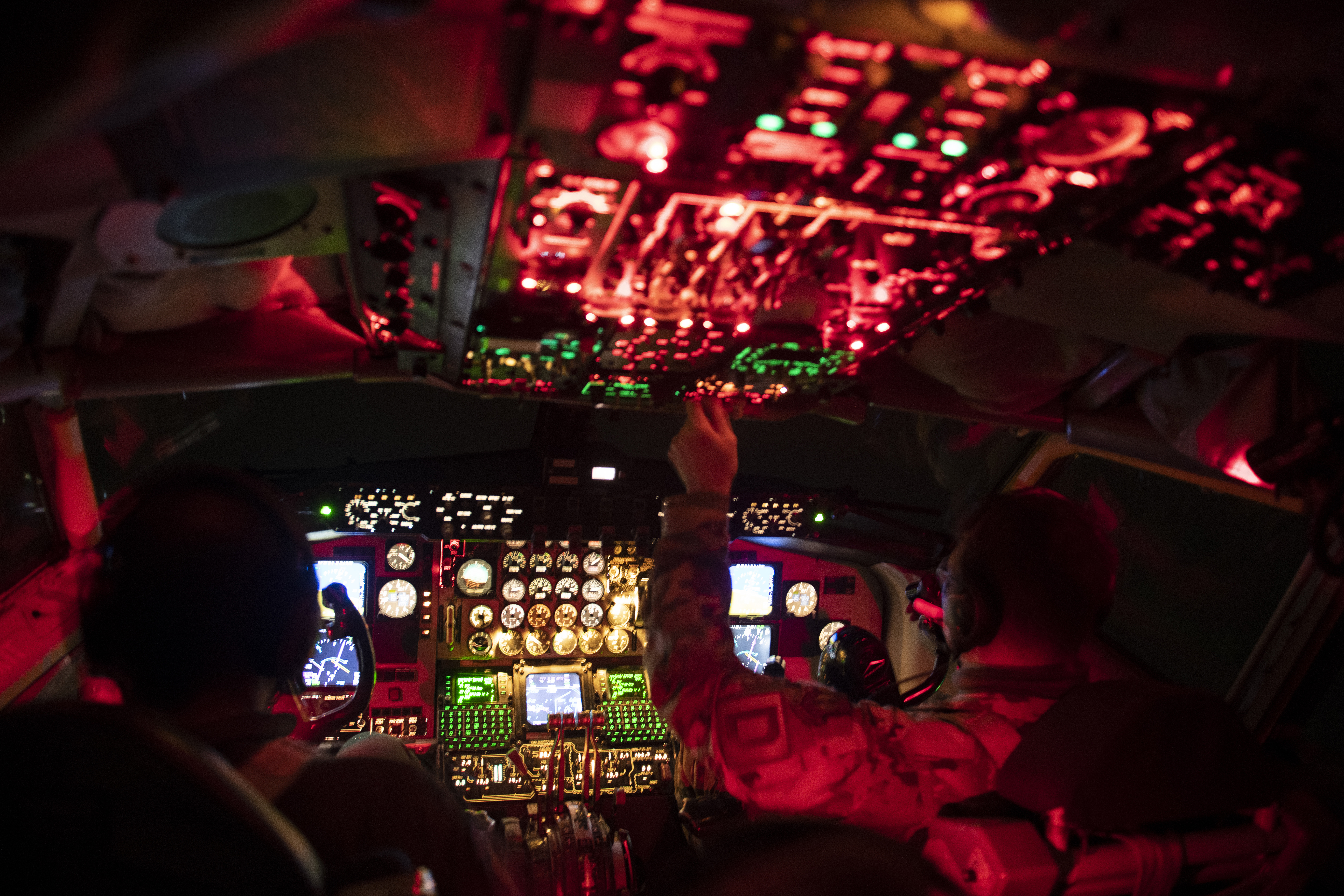
Joshua Conine, Director of Space C2 Growth and Jay Meil, Director of AI and Data Strategies and Chief Data Scientist at SAIC talk about Combined Joint All-Domain Command and Control at AFA’s 2024 Air, Space, & Cyber Conference at the Gaylord Convention Center in National Harbor, Md.
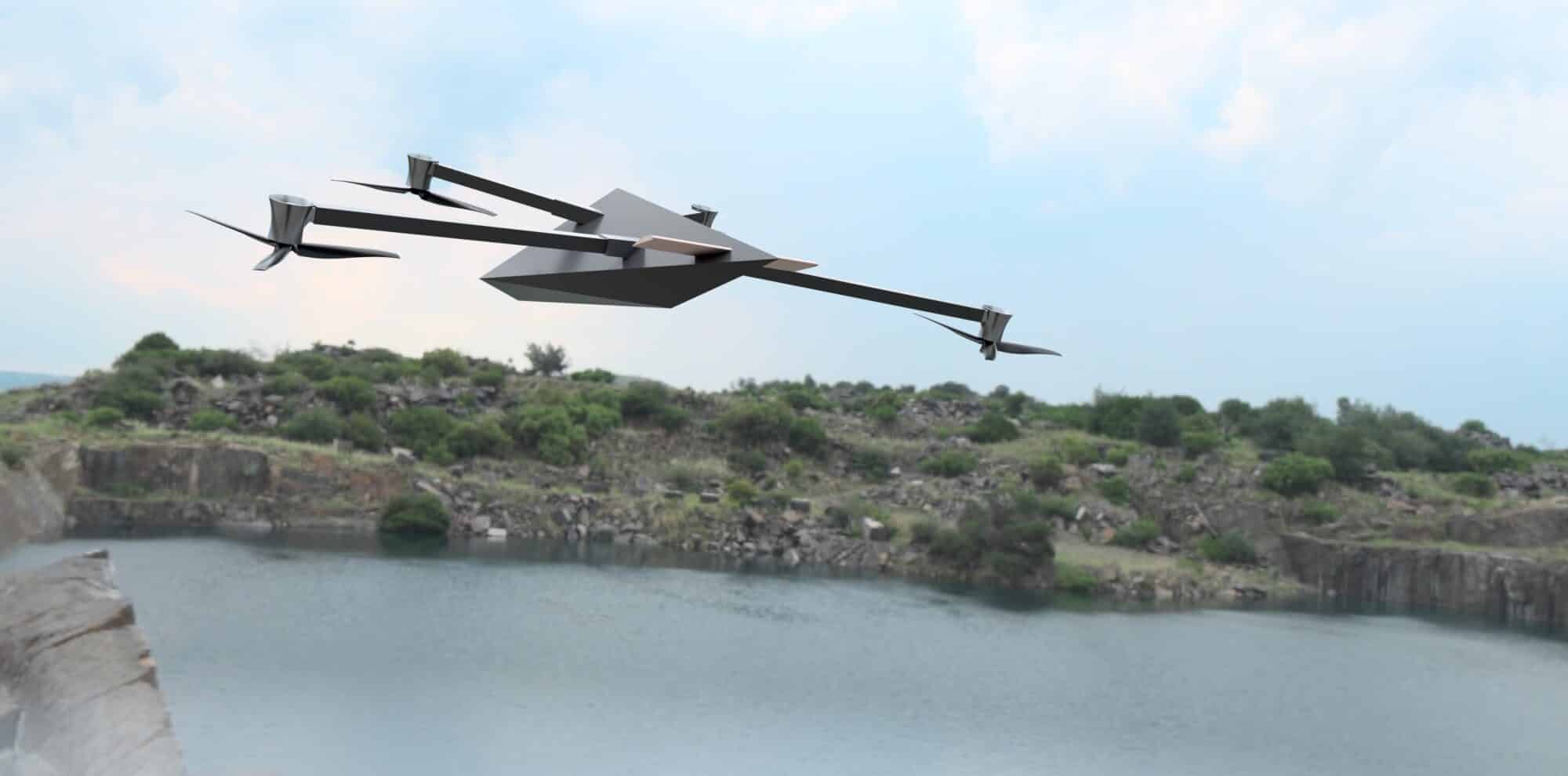
Art Boghozian, Director of Business Development for Unmanned and Counter-Unmanned Business at Amentum speaks on drones and wearable tech at the AFA’s 2024 Air, Space, & Cyber Conference at the Gaylord Convention Center in National Harbor, Md.
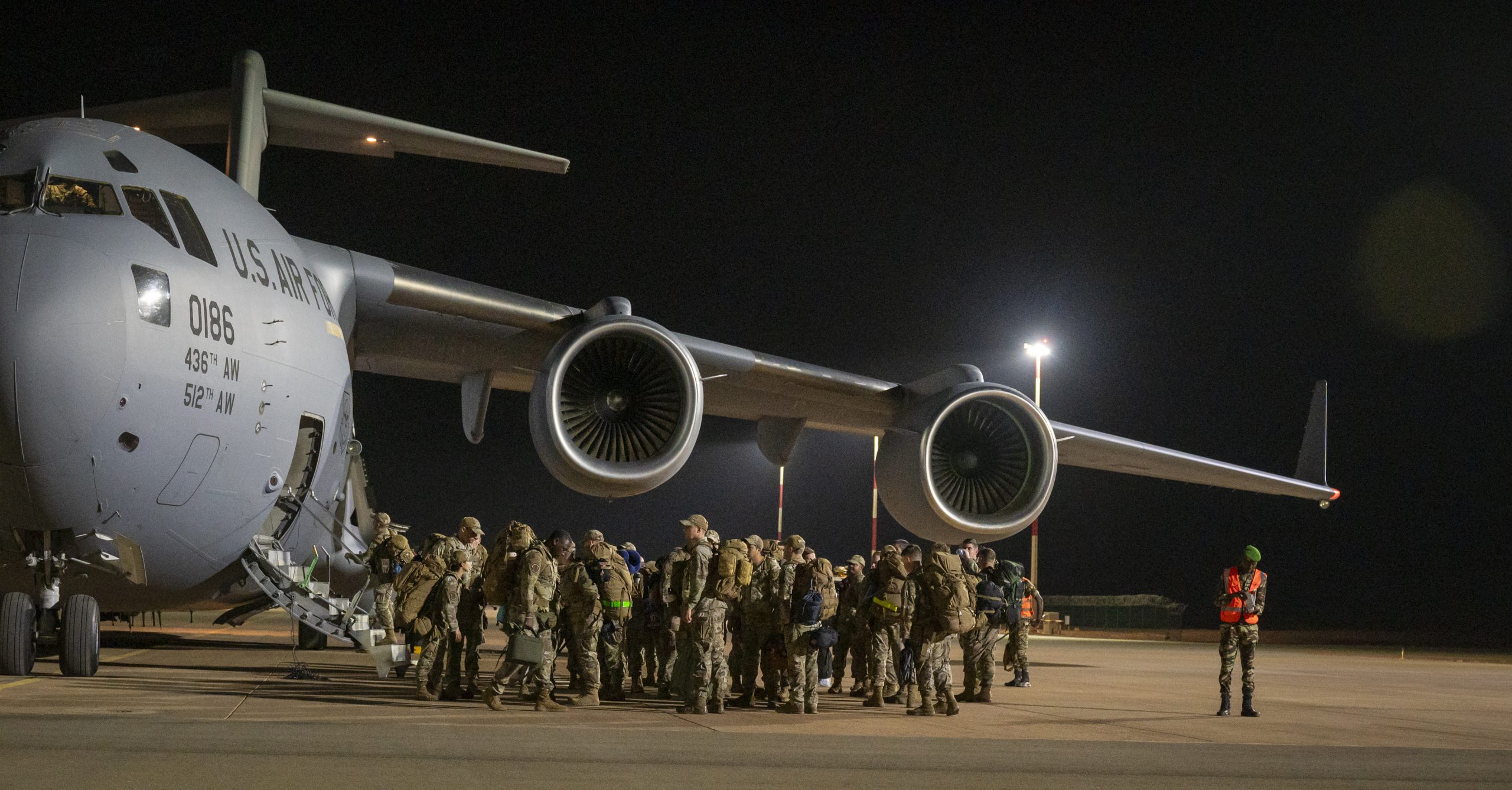
NATIONAL HARBOR, Md.—The Space Force used commercial satellite services to support the withdrawal of U.S. forces from air bases in Niger this summer, Chief of Space Operations Gen. B. Chance Saltzman said Sept. 17—a key milestone in the service’s efforts to integrate commercial capabilities into operations and dig deeper into space-based intelligence, surveillance and reconnaissance.
Saltzman highlighted the effort during a keynote address at AFA’s Air, Space & Cyber Conference here as he described the successes of the Tactical Surveillance, Reconnaissance, and Tracking (TacSRT) “pathfinder” program.
TacSRT functions as a marketplace from which the Space Force can buy tactical information from commercial providers to support combatant commanders. In speeches over the last 18 months, Saltzman has noted how the program has supported natural disaster responses across Africa, South America, and Asia; in his keynote, he said it provided “timely analysis of suspicious activities by violent extremists along the border of Rwanda and the Democratic Republic of Congo.”
Yet it was the withdrawal of troops from Air Base 201 in Niger that “stands out the most,” said Saltzman.
“In August, throughout the withdrawal, the team maintained overwatch of everything within 5 kilometers of the base,” he said. “On average, the timeline from collection on orbit to delivery into the hands of security forces was about three-and-a-half hours, but the team got it down to as little as one-and-a-half hours from collection to the security forces by the end of the event.”
Two U.S. air bases in Niger served as critical hubs for missions targeting extremist groups in the volatile region, but the Pentagon withdrew its forces after a military junta overthrew the elected Nigerien government in July 2023. Amid widespread unrest, the Space Force was able to monitor the situation in an area where situational awareness was limited for forces on the ground, Saltzman said.
“What the TacSRT pilot program does is, we simply ask a question into the marketplace: ‘Hey, what generally does it look like around Air Base 201?’” Saltzman told reporters after his keynote. “Are there any items of interest, trucks that are massing? Is there a huge parking lot? Do we see people milling around? We simply ask the question. And commercial industry provides us products that try to help us answer the question.”
Providing that information to security forces to ensure the withdrawal proceeded smoothly and safely is “just proof positive that space makes a difference and makes the joint force better,” Saltzman said.
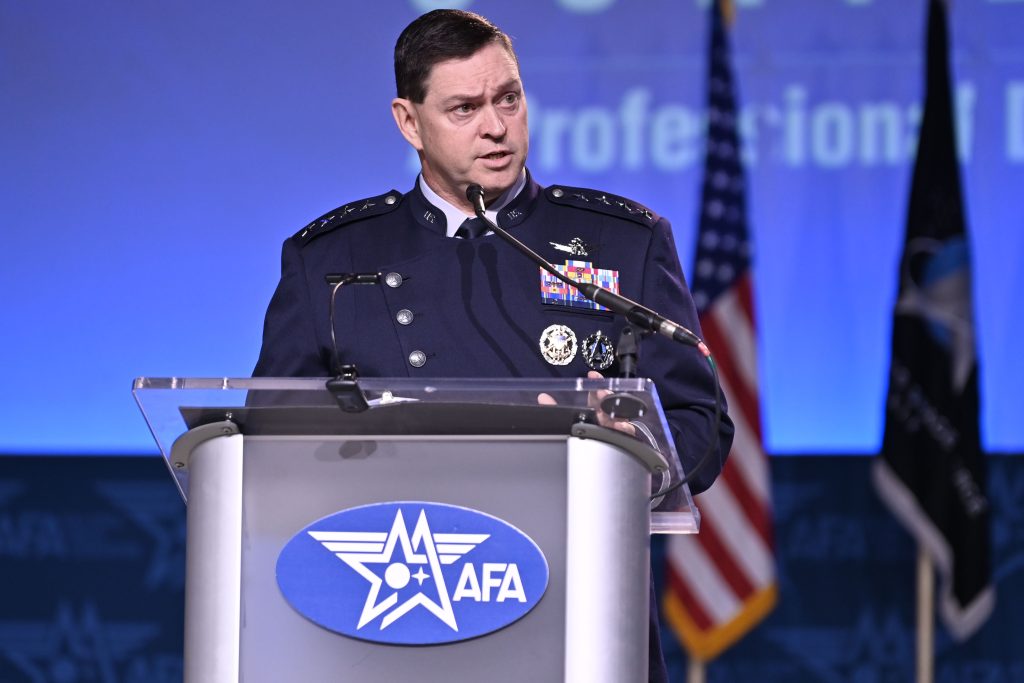
The Space Force is eager to use more commercial satellites and systems, with leaders saying it will allow them to gain and field capabilities faster than they could build themselves with limited resources. In particular, the service’s first Commercial Space Strategy ranked TacSRT fourth on a list of mission areas where the Space Force would seek to create “hybrid” architectures of military and commercial systems.
Now that TacSRT has proven it offers operational value, the question is how the Space Force will expand and fund it. Congress added $40 million for the program in fiscal 2024, and lawmakers are now debating over the level of funding for 2025.
Included in that debate are questions over the roles of the Space Force and the intelligence community. The House Appropriations Committee directed in its proposed budget bill that the Space Force and the National Geospatial-Intelligence Agency coordinate their efforts to avoid duplication, while giving the NGA director the ability to provide lawmakers with regular assessments and recommendations for the TacSRT program.
The Senate Appropriations Committee, for its part, wants to renew the program’s funding at $40 million.
Saltzman indicated that he was unconcerned about the TacSRT program stepping on any toes, saying in his keynote that it is meant “to complement the exquisite work done by the intelligence community.” Both he and Col. Richard Kniseley, the head of Space Systems Command’s Commercial Space Office, told reporters that the program is not buying imagery, but rather “operational planning products.”
TacSRT also does not provide targeting information, Saltzman noted—the Space Force and the National Reconnaissance Office are working on a separate program to deploy targeting satellites.
“It’s taking the data that’s already available, procured through the NRO and some of it through the NGA, and getting the commercial analytics to make sense of it and to figure out some pattern movements, if you will,” Kniseley said during his own media roundtable.
In that sense, Saltzman said, the program is almost akin to “surveillance as a service.”
Commercial satellite imagery has proven to be a lucrative market for everything from environmental monitoring and forecasting to disaster response, areas where the U.S. military is often called upon for help. The Pentagon wants to shift some of its own surveillance and reconnaissance enterprise for tracking threats to space as well.